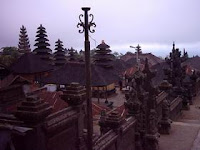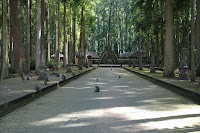The Elephant Cave - Goa Gajah - is situated on a steep bank to the side of the main road in the Banjar of Goa, Bedaulu Village in the area of Blahbatuh, Gianyar.
It is approximately twenty-six kilometres from Denpasar and is easy to find as it is by the side of the main road, just East of the crossroads in Teges village.
The countryside here is very beautiful and the cave itself is a very important archaeological site, as it holds the remains of an ancient Buddhist monument. These remains are thought to be of the same era as the grand Borobudur temple in central Java. Also the site holds relics of the God Shiva.
The origins of the name Goa Gajah are uncertain. Some claim that the name comes from the world 'Lwa Gajah' recorded in ancient Javanese writings saying the cave was the home of an important Buddhist priest. Another opinion suggests that the name originates from the statue of Gannesha which is located in the western corner of the cave, part of the statue being an elephant's trunk.
The history of Goa Gajah can be seen from the ancient remains at the site. Besides Shivaist relics found inside the cave, there are several Buddhist remains such as the statues of Buddha and Harito. These remains appear to be of the same style as the statues found in Borobudur temple, which originates in the eighth century.
Via: indo.com























